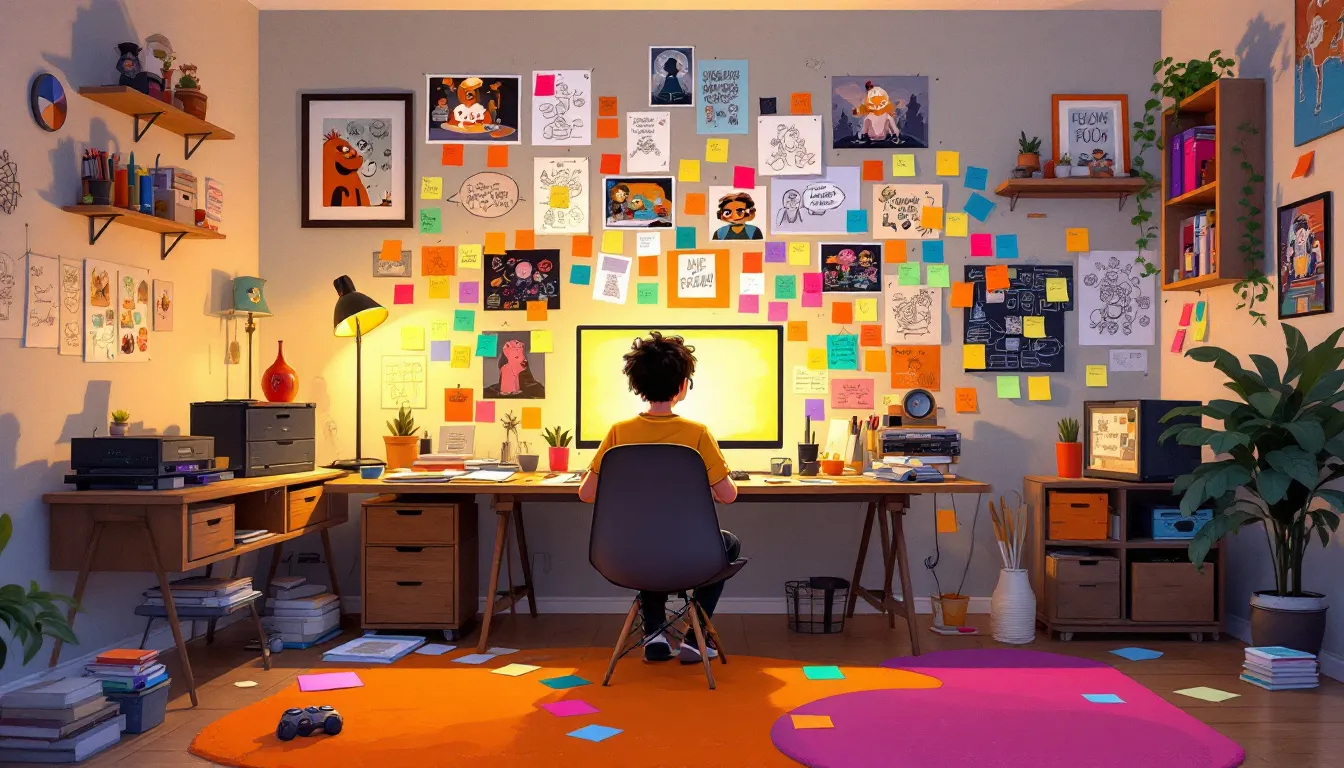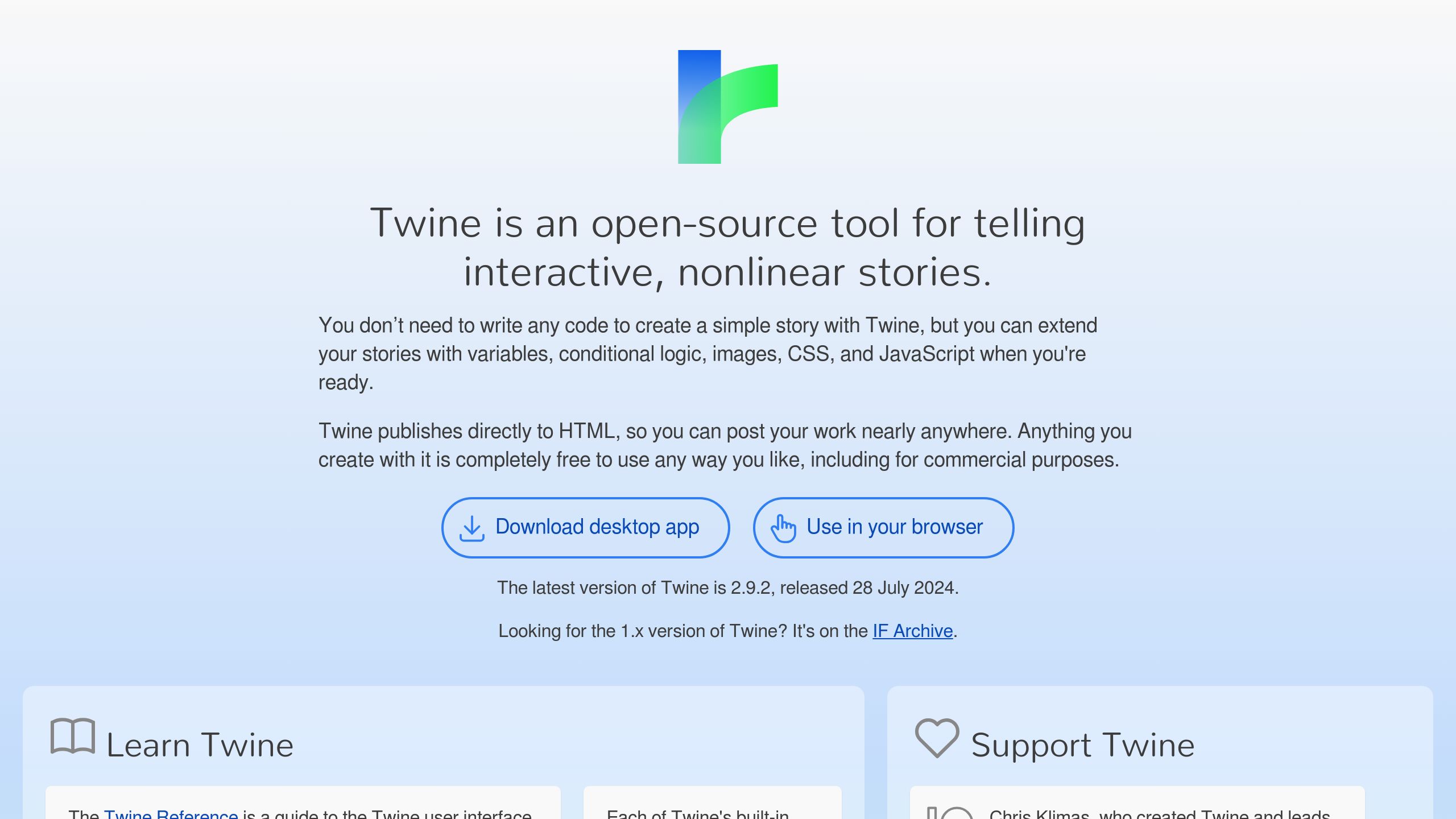
Ready to craft your own text-based adventure? Here's a quick guide to get you started:
- Plan your story and outline key decision points
- Choose a development tool like Twine, Inform, or Quest
- Write engaging narrative with meaningful player choices
- Add puzzles, challenges, and game mechanics
- Test thoroughly and refine based on feedback
- Share your game on platforms like itch.io or your own site
Key elements of great interactive fiction:
- Compelling characters and plot
- Choices that impact the story
- Multiple possible endings
- Mix of linear and branching paths
Quick comparison of popular IF tools:
| Tool | Coding Required | Best For | Ease of Use |
|---|---|---|---|
| Twine | No | Choice-based games | Easy |
| Inform | Yes | Text adventures | Moderate |
| Quest | Optional | Multimedia IF | Easy |
Ready to dive in? Let's explore how to bring your interactive story to life!
Making Interactive Fiction with Twine
Core concepts
Let's break down interactive fiction (IF). These key elements will help you create your first IF game.
Main parts of interactive fiction
IF games have three core components:
- Story: The unfolding narrative
- Choices: Decision points shaping the story
- Player interaction: How players engage with the game world
In IF, players usually control the main character through text commands. Think typing "RUN" or "HIDE" when facing alien monsters in "Planetfall" (1985).
How it's different from regular stories
IF isn't your typical linear story:
| Interactive Fiction | Linear Stories |
|---|---|
| Multiple paths and endings | Single, fixed plot |
| Player choices affect outcomes | Passive reader |
| Can include puzzles and challenges | No interactive elements |
| Often set in "rooms" for navigation | Continuous narrative flow |
Emily Short, an IF creator, puts it this way:
"It's a machine-made story you can change. If you know the rules, you can really shake things up."
This blend of set story and player agency makes IF unique.
Common tools and platforms
There are several IF creation tools:
Twine: Free, flowchart-style tool for choice-based games. No coding needed.
Inform: More advanced, uses English-based programming. Good for parser-based games.
Ink: Designed for writers, not programmers. Allows for natural writing style.
Quest: Has built-in scripting for complex logic. Supports multimedia elements.
Ren'Py: Popular for visual novels. Needs some programming know-how.
Here's a quick comparison:
| Tool | Coding Required | Output Format | Best For |
|---|---|---|---|
| Twine | No | Web-based | Choice-based games |
| Inform | Yes | Various | Text adventures |
| Ink | Minimal | Various | Branching narratives |
| Quest | Optional | Web, standalone | Multimedia IF |
| Ren'Py | Some | Various | Visual novels |
Choose based on your story type, coding skills, and desired output. Each tool creates games with different feels, so explore examples before deciding.
Planning your game
Let's dive into how to plan your first interactive fiction (IF) game.
Coming up with your story idea
Start with something that gets you fired up. Here's how:
- Read other IF games in your genre
- Get inspired by books, movies, or video games
- Use writing prompts
Kim Berkley, an IF author, says:
"Inspiration, like cats, has a way of surprising us in unlikely places when we least expect it."
Try these story starters:
- You're stuck in your favorite racing game
- Your spaceship crashes on a weird planet
- Two teams race to find the same treasure
Making a game outline
Got an idea? Great. Now outline it:
- What's your main story?
- Where are the big decisions?
- What gameplay stuff do you need?
Use this table to organize:
| Element | Description | Notes |
|---|---|---|
| Setting | [Your setting] | Key places, when it happens |
| Hero | [Character name] | What they want, what they can do |
| Problem | [Main conflict] | What's in the way, who's the bad guy |
| Choices | [Big decisions] | How they change things |
Planning story branches
Branching is key in IF. Here's the deal:
- Start small - easy choices first
- Draw out your branches
- Don't go overboard - quality beats quantity
Pro tip: Not every choice needs a new branch. Keep it simple.
Use a flowchart to see your whole story. It helps spot problems early.
Remember: Those first few choices? They're super important. They hook your players and keep them playing.
Picking a development tool
Let's look at some popular tools for creating interactive fiction games:
Twine, Inform, and Quest

1. Twine
Free and open-source. Great for nonlinear stories. No coding needed for simple games.
2. Inform
Write in plain English. Powerful, but takes time to learn.
3. Quest
Visual editor with multimedia support. Good for beginners on Windows.
| Tool | Pros | Cons | Ease of Use |
|---|---|---|---|
| Twine | Visual design, HTML export | Limited complex logic | Easy |
| Inform | Powerful, complex narratives | Steeper learning curve | Moderate |
| Quest | Beginner-friendly, multimedia | Less flexible, Windows-only | Easy |
Which tool should you pick?
It depends on your story and skills:
- New to this? Start with Twine. It's visual and easy.
- Want complex stories? Try Inform. It's powerful but takes time to learn.
- Need multimedia? Go for Quest if you're on Windows.
Pick the tool that fits your needs and get started!
Writing your interactive story
A great interactive fiction game needs a story that grabs players and won't let go. Here's how to make that happen:
Creating good stories
Focus on these key elements:
- A strong, unique premise
- Conflict that drives the story
- Well-paced action, dialogue, and description
"Writers also need to respect their audience." - Lee Sheldon, Character Development and Storytelling for Games
This means no clichés, predictable plots, or flat characters.
Making interesting characters
Characters make or break your story. To create ones players will remember:
1. Craft detailed backstories
In a few sentences, outline:
- Their upbringing
- What shaped their worldview
- Whether they've left their past behind
2. Define clear motivations
Ask:
- What does the character want now?
- Why are they in this situation?
- What's their ultimate goal?
3. Create consistent personalities
Make sure characters act in line with their backstory and motivations.
| Aspect | Key Questions |
|---|---|
| Backstory | What shaped them? |
| Motivation | What drives them? |
| Personality | How do they react? |
Giving players meaningful choices
Player agency is crucial. Here's how to make choices matter:
- Make decisions impact the story
- Don't block choices based only on stats
- Use flag-based progression for complex interactions
When designing choices, try:
- Hub and spoke: Players explore topics freely
- Waterfall: Choices flow through a linear conversation
The Walking Dead (2012) uses a waterfall structure for a cinematic feel and impactful choices.
To keep your story on track while offering choices:
- Use a critical path for key story beats
- Allow major branching at crucial moments
- Focus on personal, exciting dialogue that moves things forward
Adding game elements
Let's dive into the key components that make interactive fiction games tick.
Making important choices
Choices are the heart of interactive fiction. Here's how to make them count:
- Each choice should lead somewhere different
- No "fake" choices allowed
- Use branching for big plot points
Take "80 Days" by Inkle Studios. Players pick their route around the world. Every decision shapes the story, relationships, and ending.
Creating puzzles and challenges
Puzzles add depth. Here are some types:
| Puzzle Type | What It Is | Example |
|---|---|---|
| Information/Clue | Hidden info to find | Door code on a blotter |
| Inventory Management | Choosing what to keep | Torch or food in survival |
| Time Dependent | Beat the clock | Disarm a ticking bomb |
When crafting puzzles:
1. Make them fit the world
2. Start easy, ramp up difficulty
3. Give clear clues, but don't spoon-feed
Using variables and logic
Variables and logic make your game responsive. Here's how:
1. Use variables to track choices
2. If-then statements change the story
3. Create a stats system for outcomes
In "Choice of Robots" by Choice of Games, decisions affect "Empathy" and "Military" stats, shaping the story and ending.
sbb-itb-08f0cde
Adding visuals and sound
Let's spice up your interactive fiction game with some visual and audio elements. Here's how:
Text styles: Make it pop
Want your text to stand out? Try these:
- Bold for key info
- Italic for thoughts or foreign words
- Different sizes for headers and body text
In Twine, you can change fonts with CSS:
tw-passage { font-family: Arial, sans-serif; }
And colors:
tw-passage { color: #0000FF; } /* Blue text */
Images and sound: Bring your game to life
Images
Add images to set the scene. In Twine, it's as easy as:
const textNodes = [{
id: 1,
text: 'You enter the mysterious cave.',
image: "https://example.com/cave-image.jpg",
options: [
{ text: 'Go deeper', nextText: 2 },
{ text: 'Turn back', nextText: 3 }
]
}];
Sound
Want some spooky ambience? Use JavaScript:
var caveAmbience = new Sound("cave-ambience.mp3");
caveAmbience.play();
Pro tip: Use both .ogg and .mp3 formats for better browser support.
Make it awesome
To level up your game:
- Keep your style consistent
- Match your images and text
- Don't go overboard with sound
Here's a quick breakdown:
| Element | Why use it? | Example |
|---|---|---|
| Text styling | Highlight key info | Bold for crucial choices |
| Images | Set the scene | A spooky mansion pic |
| Sound | Create atmosphere | Creaky floors in a haunted house |
Testing and improving your game
How to playtest
Playtesting is crucial. Here's how to do it right:
Self-test first: Play your game multiple times. Try different paths. Hunt for bugs and typos.
Get testers: Find game design experts. Try the Interactive Fiction Community Forum.
Run controlled tests: Get 25-35 people to play for an hour, then survey them.
Record sessions: Capture player reactions on video for deeper insights.
Test early, test often: Don't wait for a "finished" game. Test from the start.
Getting and using feedback
Feedback is gold. Here's how to mine it:
Make a clear feedback form: Guide testers on what to look for.
Ask for regular updates: Get reports in chunks, not all at once.
Spot patterns: If multiple testers flag an issue, pay attention.
Act on it: Make changes based on feedback. Then test again.
Thank your testers: Show appreciation. Build relationships.
Ongoing improvement
Keep polishing your game:
Plan multiple versions: Expect to release several updates.
Track changes: Document what you tweak in each version.
Balance choices and story: One player said:
"It would be nicer to have a click-link for the book that has the player pick it up after clicking."
Add more interactive elements to boost engagement.
Use micro-decisions: Small choices that don't create new branches but add new text.
Show locked choices: Display unavailable options in gray. It shows players their decisions matter.
Sharing your game
You've tested and polished your interactive fiction game. Now it's time to share it. Here's how to get your game out there:
Preparing for different platforms
Make your game work on various devices:
- Web browsers: Export as HTML files and upload to a web server.
- Mobile devices: Test on different screen sizes.
- Desktop: Consider packaging as an executable file.
Where to host your game
Several platforms welcome interactive fiction:
| Platform | Pros | Cons |
|---|---|---|
| itch.io | Large indie community, customizable pages | High competition |
| textadventures.co.uk | Text game focus, built-in audience | Limited game formats |
| Your own website | Full control | Needs web hosting skills |
| Steam | Huge player base, sales potential | Strict submission, fees |
Getting people to play
Building an audience takes work:
1. Engage with communities
Share on forums like the Interactive Fiction Community Forum. Ask for feedback.
2. Use social media
Post about your game development on Twitter or Instagram.
3. Enter competitions
Submit to annual interactive fiction contests.
4. Build a mailing list
Collect emails from interested players.
5. Consider free demos
Offer part of your game for free.
"Marketing IF is extremely difficult." - Anonymous, Interactive Fiction Community Forum
To boost visibility:
- Create eye-catching screenshots or gameplay videos.
- Write a hook-y game description.
- Reach out to text-based game streamers.
Advanced techniques and future learning
Ready to level up your interactive fiction game? Let's dive into some advanced techniques and ways to keep growing your skills.
Complex game mechanics
Want to add more depth to your games? Try these:
Quality-based narrative (QBN): Use numbers to track things like inventory and skills. This lets you create different story paths based on player choices.
Salience-based narrative: Pick content that fits the current situation. It makes your story feel more alive and responsive.
Waypoint narrative: Change conversation topics based on what the player does. It's like having a real chat in your game.
Using procedural generation
Procedural generation can make each playthrough unique. Here's how:
1. Text generation
Use templates to create random, engaging text. Like this:
"Hey [Character Name]! Feeling [Emotion] today? I tried [Method] to fix it, but no luck..."
2. Puzzle generation
Tools like the Puzzle Dice System can help you create new puzzles for each game.
3. Story generation
Use AI models like GPT-4 or Claude to generate stories based on a short intro you write.
Keep learning
Want to stay sharp? Try these:
- Play with AI storytelling tools like AI Dungeon.
- Study complex games like Prom Week and Facade.
- Join the Interactive Fiction Community Forum to share ideas.
- Keep an eye out for new tools and platforms.
Conclusion
Creating your first interactive fiction game is a journey. Here's a quick recap:
1. Plan your game
Start small. Pick a simple story idea and outline it.
2. Choose a tool
Go with Twine, Quest, or Inform. Pick what fits your skills and needs.
3. Write your story
Focus on characters that grab attention and choices that matter.
4. Add game elements
Throw in puzzles and challenges. Use variables to spice things up.
5. Test and improve
Play your game. A lot. Get others to play it too.
6. Share your creation
Get your game ready for different platforms. Then, show it to the world.
Keep growing
Interactive fiction is a big playground. Here's how to keep exploring:
Join the community: Hop on the Interactive Fiction Community Forum. Share your work. Get feedback. Learn from others.
Try new stuff: Play around with quality-based narrative or procedural generation. They can add depth to your games.
Play and learn: Try out different interactive fiction games. "Counterfeit Monkey" is a good one to see cool language puzzles in action.
Never stop learning: Keep an eye on new tools and techniques. This field is always changing.
FAQs
What makes a good interactive story?
A good interactive story hooks readers with a mix of compelling narrative and meaningful choices. Here's the secret sauce:
- Characters you care about
- Choices that matter
- Multiple endings
- A mix of linear and branching paths
Emily Short, an interactive storytelling guru, puts it this way:
"Interactive stories are often presented in a branching format, in which the reader's or player's choices lead to different paths or endings."
It's like Choose Your Own Adventure on steroids.
How to play a text-based adventure game?
Text-based adventure games are all about written commands. Here's how to dive in:
1. Read everything
The game's descriptions are your eyes. Don't skim!
2. Keep it simple
Start with basic verbs like "look", "take", or "go."
3. Be clear
When interacting with objects, spell it out.
4. Get creative
Stuck? Try different commands.
Common commands look like this:
| Action | Command |
|---|---|
| Move | GO NORTH or N |
| Grab stuff | TAKE JAR |
| Check things out | EXAMINE JAR |
| What's in your pockets? | INVENTORY or I |
Lost? Type "HELP" or ask other players for a nudge in the right direction.

